Some first day of school images in New Canaan persist through the years: bright new outfits, embarrassing photo shoots at the bus stop, tearful kindergarten farewells, nervous classroom energy, locker combinations, crisp notebooks, teacher introductions, excited and awkward classmate reunions.
The playground equipment and areas have been double-checked—for example, the New Canaan Department of Public Works last month diligently crack-sealed parts of playgrounds at East and West.
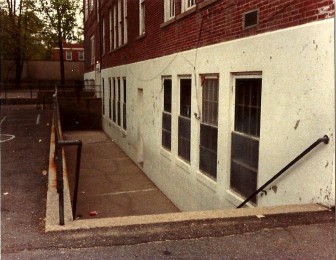
The Knockout Pit at Center School. Photo courtesy of Cam Hutchins
Yet for many years, and for scores of nostalgic New Canaanites who attended Center School—demolished after the 1982-83 academic year to make way for the Center School Parking Lot ($120 per year for a permit) opposite Maple Street from New Canaan Library—the centerpiece of the playground was a narrow, long, recessed, cement “pit” around the back of the school itself.
A place of physicality, perhaps even violence, as well as fierce competition and glory—and, of course, wholly unfathomable at an elementary school today—the Knockout Pit at Center School remains a singular touchstone for alumni more than three decades later, despite no official historical record of it and at a school far better known and remembered among educators for its innovations in student learning and curriculum.
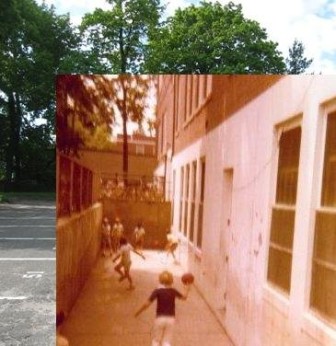
The Knockout Pit superimposed on a present-day photo of the Center School Parking Lot. Inset courtesy of Karen Corker Malner. Composed by Terry Dinan.
“My best memory of the school, other than some friends, is the Knockout Pit,” said Bill Taylor, a 1981 New Canaan High School graduate who attended Center in the early-‘70s.
“I talk about it to this day, and you really can’t explain it to people. It put a smile on your face, whether it was lunch or after school, sometimes even before school. It was a popular place and a fun place: You kill each other, and then you just go about your business.”
The rules in the Knockout Pit, most of those interviewed for this article agreed, were similar to other dodgeball games—though, once eliminated, there was no re-entering the game at Center. Using the old red rubber kickballs of the day, an even number of players lined up on either side of a halfway line and threw the ball across it, trying to get others out by striking them with the ball without having it caught in the air. The Knockout Pit had “quarter lines” that could be used to eliminate the very last player left on an opposing team.
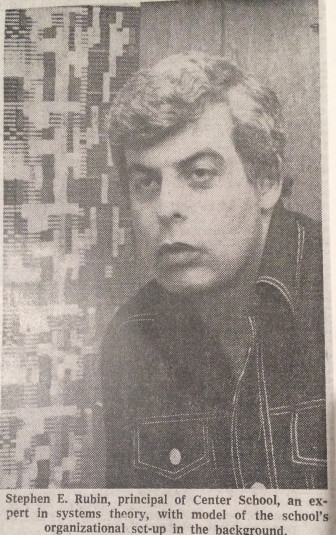
Dr. Stephen Rubin in a 1976 New York Times newspaper clipping. Courtesy of the New Canaan Historical Society.
No one seems to know just when the Knockout Pit was dug and poured—its dimensions are measurable today with visible cracks in the concrete above it—what its original purpose was or just how long after its creation kids started playing knockout there.
Dr. Stephen Rubin, who led center school as its principal from 1965 through its closing in 1983, recalled “sanctioning” use of the narrow cement corridor accessible by way of a staircase or through a cafeteria door, soon after taking the reins.
“It was something that a lot of kids enjoyed—it was, for some, a little scary experience,” Rubin recalled. “But it was adequately monitored and supervised. It’s a dodgeball game, and anybody that abused that was removed from the Knockout Pit.”
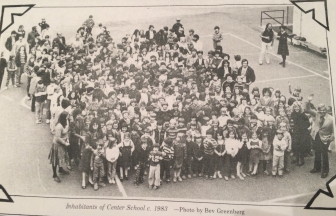
Photo taken from Center School, looking down on students, teachers and faculty, just prior to the end of the 1983 school year, by Bev Greenberg. Courtesy of the New Canaan Historical Society.
That would happen, Rubin said, when kids became too aggressive.
“They came too close to the opposite side so that they had an unfair advantage,” he said.
Rubin added: “The Knockout Pit was a very informal fun time for a lot of kids, and it almost was in contrast to what went on in the school, which had a lot of very technical components.”
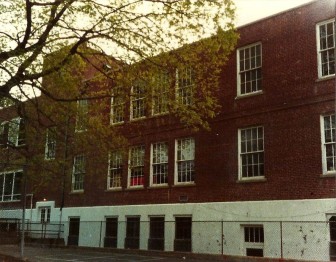
Center School, Knockout Pit in foreground (below ground level). Photo courtesy of Cam Hutchins
That included a system of learning whereby students experienced a highly individualized, tailored program. For Center School alum and town resident Cam Hutchins, singular elements of Center that include the way kids learned and Knockout Pit all made it a special place.
“Obviously there’s the curriculum, but there was also the whole playground cycle, where you’d make snow banks in the winter and then slide down them because it seemed like the Alps in grade school,” Hutchins said. “And then in the spring it would melt and there would be rivers in the dirt part of the field and you’d make dams—spend the whole recess making a dam and then let it go before the bell rings. There were drip paintings in Sue Connell’s art class and Pris Carroll’s music class, composing your own music and then presenting it in front of the whole school.”
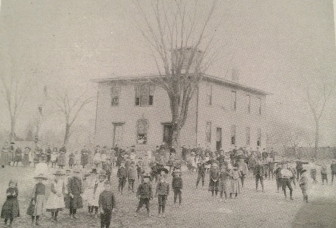
The original Center School. Courtesy of the New Canaan Historical Society.
The school itself was an historic structure. A school building stood on the site of Center in 1856, when the town purchased the land there for $881.25, according to documents on file at the New Canaan Historical Society (a member-supported organization).
When enrollment hit 240 in 1894, an addition was needed, and 14 years later New Canaan determined that an entirely new building was needed. A new, brick building was constructed for about $45,000 in 1910, with another addition going in 10 years later.
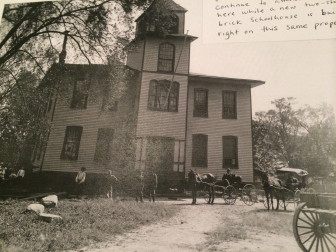
Center School ca. 1894, after an addition to the original structure. Courtesy of the New Canaan Historical Society.
In 1940, Center School required more space again and so six classrooms and an auditorium were added—as well as a cafeteria.
Though the cafeteria was located in the same area of the building that students will remember it—basement level, east side of the school, according to a 1940 site plan on file at the historical society—it makes no mention of a service entrance midway on the far cafeteria wall (the infamous door to The Knockout Pit).
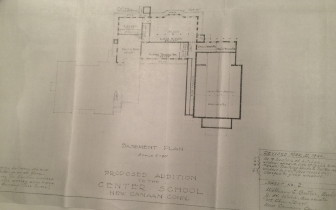
A site plan for a 1940 addition to Center School. Courtesy of the New Canaan Historical Society.
However, New Canaan Advertiser articles from renovations planned and completed between 1956 and 1958 note that, for example, “a major item in the modernization program includes renovations throughout the building to ensure compliance with the fire safety code.”
It could well be that what would become the Knockout Pit, and the door to it from the cafeteria, represented a sorely needed fire exit, Hutchins said. Part of the purpose of digging up the Knockout Pit also may have been to let light into the cafeteria windows, or as a delivery route (though, as Hutchins noted, a more accessible, recessed entrance to the basement level of Center was located just around the corner from the Pit).

The rebuilt Center School, ca. 1910. Courtesy of the New Canaan Historical Society.
Whenever it was created, and for whatever reason, the Knockout Pit eludes the historical record. Even newspaper articles published in the mid- to late-1970s that dealt specifically with Center School’s playground areas (and the need to expand them by acquiring adjacent properties, which was done) fail to mention it.
“Dr. Rubin said the new playground will be designed by William Weisz, New York City architect who specializes in using materials readily available to keep construction costs down,” reads a Sept. 30, 1976 article on the volunteer-led effort to carve out a new playground area at the corner of Main and Maple Streets.
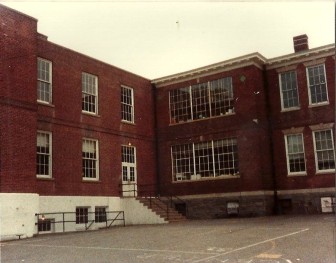
Center School. You can see another stairway headed down to the basement level on the left, just around the corner from the Knockout Pit. Photo courtesy of Cam Hutchins
“Center School’s playground is split into three areas. In front of the school is the kindergarten space and in back are separate areas for grades one and two and grades three through six. Because the playground for the first and second graders has not been very attractive due to its washed out condition, those children were more inclined to participate with the ‘upper classmen,’ thus limiting the activities for both groups, the principal explained.”
Rubin during our interview for this Knockout Pit article did recall one incident specifically, where “one kid got bitten by a bunch of hornets down there and we rushed him to the nurse.”
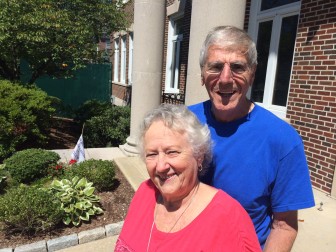
Vicki and Vincenzo Socci of New Canaan. Vicki worked four days per week through Visiting Nurse at Center School. The couple has lived on Parade Hill Road for more than 50 years. Credit: Michael Dinan
That boy may well have paid a visit to Vicki Socci, who worked as a nurse at Center four days a week from about 1969 through the final year of ’83.
Socci, a mother of four (three of whom went to Center, including current New Canaan Fire Department Capt. Michael Socci), still lives in the Parade Hill Road home she and her husband bought in 1960—right next door to the now-demolished former home of Syd and Bev Greenberg, a couple that, between them, have probably done more to preserve the history of Center School than anyone.
Socci said injuries from the Knockout Pit, including among her own kids, spanned broken and sprained wrists to bruises, cuts and scrapes.
“They’d come in from the Knockout Pit and naturally I would put the board in and tape it,” Socci recalled.
The Knockout Pit wasn’t very popular among parents, recalled Janet Lindstrom, whose two children went through the school and who long has served as executive director of the New Canaan Historical Society.
“I didn’t like it,” Lindstrom said. “It was dangerous.”
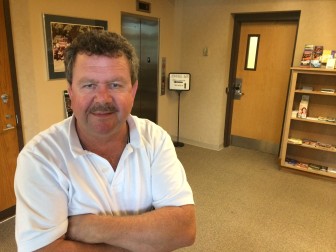
Mose Saccary, a Center School alumnus who like many of us was terrified of the Knockout Pit, graduated from NCHS in 1978 and now serves as head of the New Canaan Highway Department division of the DPW. Credit: Michael Dinan
Mose Saccary, a Center School alum who would go on to graduate from New Canaan High School in 1978, said he remembered “the ringing of the ball coming off the wall as it just missed your head, from the sixth graders at the free throw line and then I remember not getting hit because I was so scared to get hit.”
Nevertheless, Saccary said he was in the Knockout Pit every day, “choking food down to try and get to the Knockout Pit. I’d run out there.”
He added: “That’s if Mrs. Stone didn’t make you eat your carrots,” recalling a widely feared and respected teacher at the school.
Town resident Len Paglialunga, a late-1950s Center School student who would go on to become a football star at the high school, said he spent “hours and hours” in the Knockout Pit.
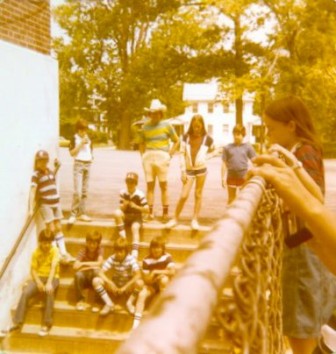
Onlookers always gathered on the stairs and along the chain link fence that ran the length of the knockout pit.
“One of the bad things was when the girls got caught in all the crossfire of the knockout game,” he recalled with a smile. “But it was just great fun. It was just absolute great fun. You’d come out of the lunchroom door, and you’re throwing the ball back and forth and the ball is whizzing by people’s heads. ‘What is going on here?’ It was great.”
“It set you up for life,” Paglialunga said. “You either survived or you didn’t survive.”
To continue on with the scenic memories my brother, Cam Hutchins, evokes, I recall that in later spring, once those dirt playground “rivers” had dried up, “Marble Season” was upon us! Marble Season, to some extent, was an equalizer where younger students had the courage and conviction to challenge older students for a game of marbles where accuracy, agility, and precision prevailed – it was not all necessarily about student height and muscle mass!
And then of course there was the highlight of the year – Field Day – where Mr. Milot made every single competitor feel like an Olympian! Great, joyous memories!
Dani thank you for sharing that—such great memories. I was part of Center School’s very last second grade class, and was cast off to East the next year with my brother and sister. One of my fondest memories at Center, before I ever set foot in Yankee Stadium, was jockeying for position in the first-grade rooms to get a good spot to watch the student-faculty kickball game. During our interview, Bill Taylor mentioned how it was so cool that there were live spectators surrounding the Knockout Pit and it occurs to me that with that, the marbles, the music performances and so on, there was a feeling at Center of bringing extra special attention to, and celebrating what the students were doing all the time.
I attended Center School from 1955-1961 and I can tell you the knockout pit was already old when I got there. It absolutely predates the 1956-58 renovations which I remember very well (hello “Telephone Building” or South Main Street School as it was properly named).
Sometime in the 1957-58 school year, during the renovations referenced in the article, a workman fell into the pit and to his death from the roof or some high scaffolding. I remember my 3rd grade teacher, Miss Pamela Tucker, talking to the class about it, trying to help us understand what had happened. The area was closed off for some days and when it was reopened we went right back to having the great times in there we always had. Still, I thought about it every time I climbed stairs out of there the rest of my time at Center.
Never occurred to me that everyone didn’t play knockout. There was a gutter that ran along the concrete wall on the side across from the cafeteria where you would sit after you got knocked out.
Remember there were 3 kickball courts – the one closest to the knockout pit had trees at the far end and it was great if you could kick the ball over the trees like a home run!
They plowed the paved part of the playground to the edge where it met the dirt and we’d have great times sliding down and building tunnels.
You knew it was spring as the snow melted and the mounds disappeared – then it was marble time – cats eyes, steeleys (sp?) and shooters.
Never forget Mrs. Stone and reading about Dick & Jane, Mrs. Woodward was my 2nd grade teacher when President Kennedy was assassinated, and Mr. Chisholm who used to throw chalk.
Great memories!!
I’ve witnessed kids losing teeth in the beautiful memory that I have of “the pit” !!!! Best times at that school!!
Old topic, but great memories. The man who fell into the pit due to a failed scaffolding occured in 1957; he was working on the Miss Buyer’s window.
Perhaps a source of more injuries was the South Ave. playground merry-go-round. Set on gravel, it was made of weathered and splintered wood with steel bars to grag onto or hit when anyone tried to spin you off. The major threat was getting your leg caught underneath it when trying to build up speed. It was a.lot more fun then the rusty jungle-gym or slide.
Haha I remember the Knockout Pit all too well! I was a student around 74-76. I was the oddball kid from California who rode a skateboard and wore these weird canvas multi-colored shoes called “Vans”. Top-siders were the choice of 99.9% of the kids but I never caved lol